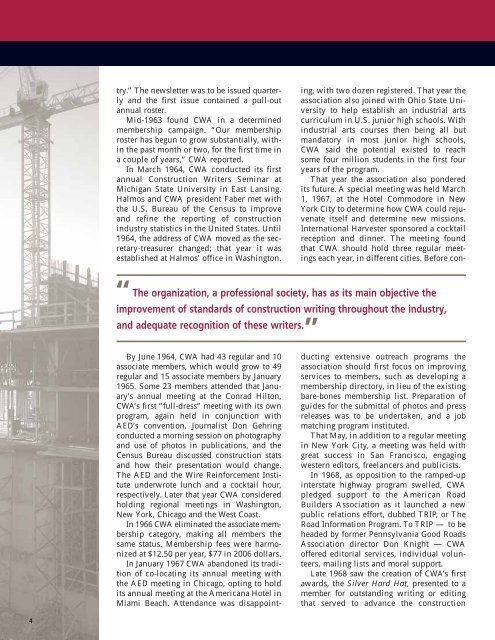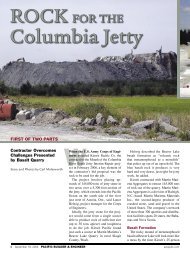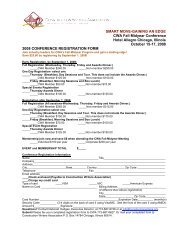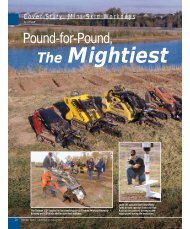A Concise History - Construction Writers Associations
A Concise History - Construction Writers Associations
A Concise History - Construction Writers Associations
You also want an ePaper? Increase the reach of your titles
YUMPU automatically turns print PDFs into web optimized ePapers that Google loves.
try.” The newsletter was to be issued quarterly<br />
and the first issue contained a pull-out<br />
annual roster.<br />
Mid-1963 found CWA in a determined<br />
membership campaign. “Our membership<br />
roster has begun to grow substantially, within<br />
the past month or two, for the first time in<br />
a couple of years,” CWA reported.<br />
In March 1964, CWA conducted its first<br />
annual <strong>Construction</strong> <strong>Writers</strong> Seminar at<br />
Michigan State University in East Lansing.<br />
Halmos and CWA president Faber met with<br />
the U.S. Bureau of the Census to improve<br />
and refine the reporting of construction<br />
industry statistics in the United States. Until<br />
1964, the address of CWA moved as the secretary-treasurer<br />
changed; that year it was<br />
established at Halmos’ office in Washington.<br />
“<br />
The organization, a professional society, has as its main objective the<br />
improvement of standards of construction writing throughout the industry,<br />
and adequate recognition of these writers. ”<br />
By June 1964, CWA had 43 regular and 10<br />
associate members, which would grow to 49<br />
regular and 15 associate members by January<br />
1965. Some 23 members attended that January’s<br />
annual meeting at the Conrad Hilton,<br />
CWA’s first “full-dress” meeting with its own<br />
program, again held in conjunction with<br />
AED’s convention. Journalist Don Gehring<br />
conducted a morning session on photography<br />
and use of photos in publications, and the<br />
Census Bureau discussed construction stats<br />
and how their presentation would change.<br />
The AED and the Wire Reinforcement Institute<br />
underwrote lunch and a cocktail hour,<br />
respectively. Later that year CWA considered<br />
holding regional meetings in Washington,<br />
New York, Chicago and the West Coast.<br />
In 1966 CWA eliminated the associate membership<br />
category, making all members the<br />
same status. Membership fees were harmonized<br />
at $12.50 per year, $77 in 2006 dollars.<br />
In January 1967 CWA abandoned its tradition<br />
of co-locating its annual meeting with<br />
the AED meeting in Chicago, opting to hold<br />
its annual meeting at the Americana Hotel in<br />
Miami Beach. Attendance was disappointing,<br />
with two dozen registered. That year the<br />
association also joined with Ohio State University<br />
to help establish an industrial arts<br />
curriculum in U.S. junior high schools. With<br />
industrial arts courses then being all but<br />
mandatory in most junior high schools,<br />
CWA said the potential existed to reach<br />
some four million students in the first four<br />
years of the program.<br />
That year the association also pondered<br />
its future. A special meeting was held March<br />
1, 1967, at the Hotel Commodore in New<br />
York City to determine how CWA could rejuvenate<br />
itself and determine new missions.<br />
International Harvester sponsored a cocktail<br />
reception and dinner. The meeting found<br />
that CWA should hold three regular meetings<br />
each year, in different cities. Before conducting<br />
extensive outreach programs the<br />
association should first focus on improving<br />
services to members, such as developing a<br />
membership directory, in lieu of the existing<br />
bare-bones membership list. Preparation of<br />
guides for the submittal of photos and press<br />
releases was to be undertaken, and a job<br />
matching program instituted.<br />
That May, in addition to a regular meeting<br />
in New York City, a meeting was held with<br />
great success in San Francisco, engaging<br />
western editors, freelancers and publicists.<br />
In 1968, as opposition to the ramped-up<br />
interstate highway program swelled, CWA<br />
pledged support to the American Road<br />
Builders Association as it launched a new<br />
public relations effort, dubbed TRIP, or The<br />
Road Information Program. To TRIP — to be<br />
headed by former Pennsylvania Good Roads<br />
Association director Don Knight — CWA<br />
offered editorial services, individual volunteers,<br />
mailing lists and moral support.<br />
Late 1968 saw the creation of CWA’s first<br />
awards, the Silver Hard Hat, presented to a<br />
member for outstanding writing or editing<br />
that served to advance the construction<br />
4








